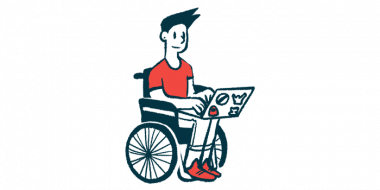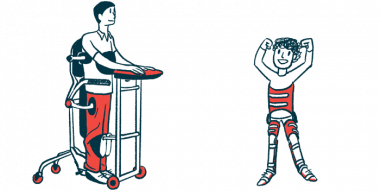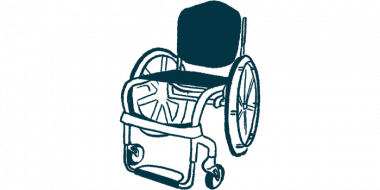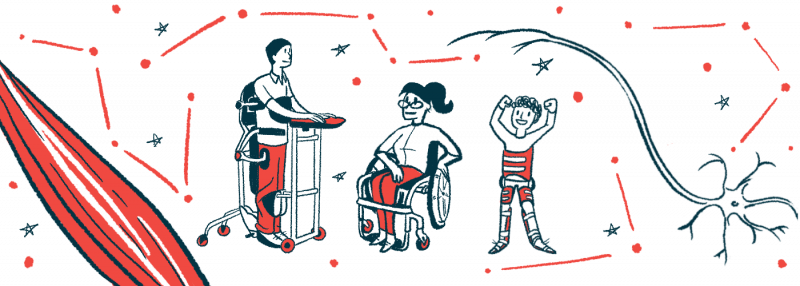
Specialized Equipment for SMA Patients SMA patients often need specialized equipment to help support them in daily activities, assist with mobility, and aid with breathing, coughing and swallowing issues. Equipment needs depend on the severity of the condition. They can range from simpler walking aids, such as braces and grab bars, to electric wheelchairs, bath chairs, breathing and feeding equipment, and car beds for traveling. |
|---|
 Did You Know? A 2021 study highlighted the need for assistive equipment to enhance the function, fun, and social participation in children with severe disabilities such as SMA. Researchers presented a review of the available literature on assistive devices and equipment, as well as a case report of a 5-year-old boy with SMA type 1, who uses a variety of devices to enhance his everyday life. |
|---|
“It’s common for people to say things like, ‘That must be like your car breaking,’ when an SMA individual has issues with their wheelchair. The reality is that when our wheelchairs or robotic arms mess up, it’s the equivalent of an able-bodied person’s legs and arms not working. People don’t realize just how dependent we are on devices and technologies in our everyday lives.”— Kevin Schaefer, columnist, “Embracing My Inner Alien” |
|---|
 Did You Know? It is recommended that children with neuromuscular disorders like SMA begin using wheelchairs and other assistive devices before they begin to have mobility issues, if possible. This transition can be difficult for parents. In a survey of 17 Australian families who had children with neuromuscular disorders, including SMA, parents reported being hesitant at first to implement wheelchair use, but seeing their children use the equipment and gain the independence it offered helped them accept the use of a wheelchair and recognize its benefits. |
|---|
“My first power wheelchair was a dream of maneuverability for my kindergarten kid spirit. It had a lavender seat, gripping tires for coarse paths of adventure, and a joystick that mimicked a compass, allowing me to pilot thermal winds of adaptability.It reinforced the notion that I was worthy of experiencing life no matter what physical condition my body was born into, even if it deviated from societal norms.”— Katie Napiwocki, columnist, “A Wildflower in the Wheelderness” |
|---|

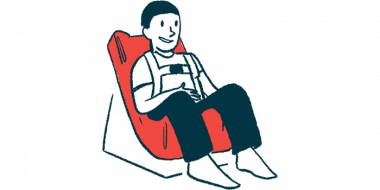
At Home
A number of home modifications can be made to improve the accessibility and safety of the home for people with SMA. These can include installing guardrails, widening doorways to accommodate wheelchairs, or implementing smart technology to turn lights on and off, control the thermostat, or lock doors.
Mechanical lifts can be installed in bedrooms to help with getting in and out of bed. Outside, ramps may be needed to make the home accessible for wheelchair users. Bathroom modifications may include installing grab bars or a roll-in shower. Toilets and sinks can also be raised or lowered as needed for the individual.
Two kinds of specialized equipment almost always needed in the home are bath chairs and feeder seats.
Bath Chairs
These chairs ensure that bathing is safe and secure for children and adults with special needs. They typically can be adjusted to different positions depending on the person’s requirements, and the height can also be adjusted according to the needs of the parent or caregiver.
The selection of bath chairs and supports is wide, and selection should be made according to personal needs and financial abilities.
Feeder Seats
Specially designed feeder seats exist for all ages. These are typically soft foam positioning seats that are fairly easy to use. They can be a good alternative to a wheelchair or stander.

“We purposely bought our current house because the doorways from room to room are wide enough for [Ella’s] wheelchair. The hallway is wide enough for her to turn around in, and the furniture is strategically placed to give ample room to ‘run’ through the house — and run she does!Modifying a house for a wheelchair requires trial and error. In doing so, one can expect some bumps along the way. The key lies in encouraging the drivers they can do certain things, and to reassure them if they accidentally break something.”— Michael Casten, columnist, “Five Servings of Strength” |
|---|
 Did You Know?
|
|---|
“Vacations offer opportunities to explore a different part of the world and take a break from normal routines. But sometimes there are things you can’t take a break from.SMA is one of those things. We can’t leave it with the house sitter or turn it off during the trip. Even on vacation, we have to set aside time for medications, rest, and thrice daily medical routines. There’s also the possibility that we’ll encounter inaccessible locations.None of that means we don’t enjoy our trips, though. With a bit of creative planning, flexibility, and my mom’s expert strategizing, traveling with SMA can still be fun.”– Halsey Blocher, columnist, “From Where I Sit” |
|---|


Equipment to Assist With Breathing
People with SMA often have difficulties with breathing, sucking, and swallowing. These issues arise due to the weakness of the intercostal muscles (muscles supporting the chest wall), leaving the diaphragm as the primarily breathing muscle.
This weakness creates a serious health danger, because people with SMA often develop respiratory complications, including those due to lung underdevelopment and weak cough, and are vulnerable to respiratory tract infections, aspiration of food and fluids, and sleep problems with hypoventilation.
Assistive devices are available that may help SMA patients with breathing, coughing, or swallowing problems.
A bi-level positive airway pressure (BiPAP) machine can sense a person’s normal breathing cycle and work with it. The device provides a user with higher pressure and an increased volume of air while inhaling, and automatically lowers the pressure when the person is exhaling. It also helps users who are not breathing properly because they are sleeping. The airway pressure is delivered through a mask that’s either over the nose or over both the nose and mouth, or through a tube running from under the nose into the nostrils.
A cough assist machine helps maintain airway clearance. This device uses a positive air pressure that rapidly changes to negative pressure, assisting the patient with coughing. When the child breathes in, the machine provides air (positive pressure) to expand the lungs; when breathing out, the machine rapidly creates a sucking force (negative pressure), helping to remove air from the lungs.
A pulse oximeter is a small, portable clamp or band-aid-like device that is used to check blood oxygen levels through a finger or a toe. It alerts users to blood-oxygen-level problems or if they need help with coughing. People with SMA need extra breathing support when oxygen levels drop too low.

 Did You Know? Progressive difficulty breathing is the most common non-neurological symptom and leading cause of mortality in SMA. A 2020 study in 437 untreated children with SMA found that declines in lung function are steeper and quicker in children with SMA type 2 than non-ambulatory children with SMA type 3. However, these rates of decline slowed and differences eased around age 13. |
|---|
“I owe a large part of my health and well-being to my pesky BiPAP machine. For all its frustrating nuances, it does kind of keep me alive. Since I had respiratory surgery in 2011 to clear the airways in my throat, I’ve been able to breathe significantly better at night, but not without help.Living with SMA comes with a lot of specialized equipment, at all times of the day. Sleep is one of the more complex and challenging aspects of my life, but I probably wouldn’t rest at all without my Vader machine at my side.”— Kevin Schaefer |
|---|
